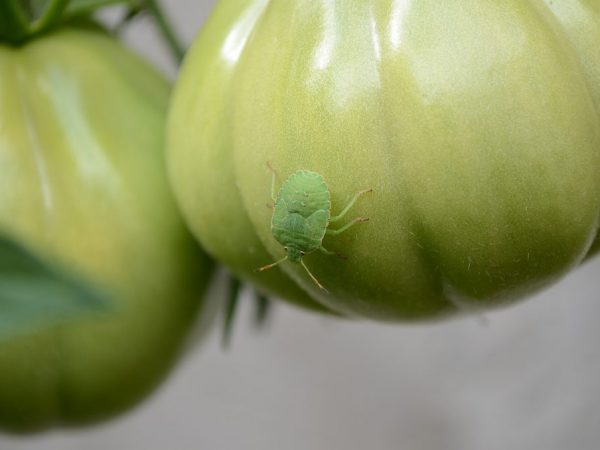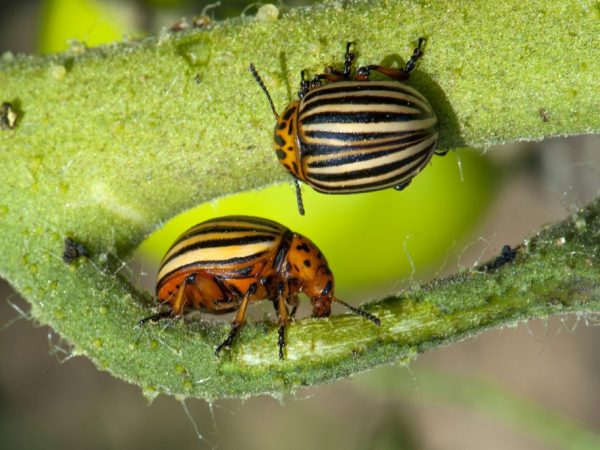How to deal with pests of tomato seedlings
Tomato seedlings during the period of active growth are susceptible to pests and diseases. Pests of tomato seedlings can damage the root system of the future bush and its upper green part. Timely cleaning of seedlings is carried out using purchased or homemade products.

Pest control of tomato seedlings
To prevent tomato pests from destroying the future crop, it is necessary to carry out prevention and strengthen the seeds before planting in open ground or in a greenhouse.
Characteristics of pests
Diseases and pests of tomatoes directly depend on the variety of the selected crop and the soil in which it is planted. Insects and pests are divided into 2 types:
- those that eat the root of tomato seedlings (underground part of the bush);
- those that feed on flowers, stems and leaves.
Pests of tomato seedlings and methods of dealing with them depend on the time of planting seedlings: if the culture is planted in a greenhouse in the cold season, one should beware of insects that eat the ground part of the bush. Root-eating insects and beetles are dangerous for tomatoes outdoors.
Pests feed on plant juices, its green part or fruits. Depending on the type of insects or beetles, the leaves of the bush wither or the leg rots. Treatment methods are determined by the type of pest and are used to treat nearby healthy crops.
Medvedka on seedlings
The bear insects are relatives of the locust.
The bear has a well-developed front part of the body, which allows the pest to rake the soil. The length of the insect is no more than 10 cm, the color of the body is brown or dark brown.
For tomatoes, both adults and small larvae are dangerous. The main goal of the bear is the root system, which the insect eats up for weeks until the bush is completely destroyed. The pest is found only on open ground, and it is impossible to meet it in the greenhouse.
Control methods
The fight against the bear includes the cultivation of the entire land plot.
Spraying only bushes of tomato seedlings is ineffective. For processing, granular products are used, which, unlike chemicals, do not affect the quality of the soil. Popular drugs against the bear:
- "Granule";
- "Medvetox";
- "Force".
The fight against the bear begins with loosening the soil (the upper layers are 1-2 cm). The preparation granules are buried in the soil and covered with earth. The pest can easily find the pellets, but pets or animals will not eat them.
To combat the bear, folk remedies are used: the insect is scared away by strong odors. During the planting of seedlings in the open field, garlic or bulbs (in extreme cases, stale meat or fish) are buried around the beds. Such ingredients will not affect the well-being of people, but they will scare the bear away.
Traps are used to catch large numbers of locusts. To do this, you need to mix rotted manure with purchased baits. Home remedies work with beer or sunflower oil.
Colorado beetle
The pest of tomatoes is the Colorado potato beetle, which can grow both in the garden and in the greenhouse.
Eating seedlings begins with the appearance of the first green leaves on the stem.
Beetles emerge from bright orange larvae. Both adults and their eggs are dangerous for tomatoes. Most often, it is the larvae that eat the foliage, but the beetles feed on the tops only at the end of summer.
Beetle fighting
Tomato tops are mechanically cleaned from the Colorado potato beetle.
For mass processing of a land plot, specialized insecticides are suitable. Such products protect the plant from pests until harvest.

Colorado potato beetle larvae harm plants
Insecticide treatment is carried out on neighboring crops: the Colorado potato beetle loves the tops of eggplant and potatoes, and if only the beetle larvae are collected, the adults will again produce offspring. Only an integrated approach will solve the problem.
Garden scoop
The fight against dangerous pests of tomatoes begins in early spring when preparing the soil for seedlings.
Caterpillars are common pests. Tomato leaves suffer from the scoop, but it rarely gets to the roots. Gradually the plant turns into a "sieve" and the bush withers. Getting inside the stem, the scoop completely destroys the seedlings.
The scoop grows up to 3 cm in length. The first generation of caterpillars grows on weeds, so they get rid of them first. The larvae multiply rapidly and survive even in adverse conditions.
Pest control
In cases of the spread of caterpillar larvae, the use of insecticides is necessary.
You need to spray dry leaves at an ambient temperature below 20 ° C. For spraying seedlings, "Arrivo" or "Decis" is useful - a purchased insecticide safe for humans.
Folk remedies will help get rid of a dangerous caterpillar: to prepare a homemade solution, you will need grated dry soap, blooming wormwood and wood ash. All components of the product are thoroughly mixed and 10 liters of pure boiling water are poured. The mixture should stand for at least 6-10 hours. The finished product can be sprayed on all seedlings of tomatoes and neighboring crops.
Tomato wireworm
Wireworms are dangerous for tomato seedlings. The fight against them begins in the spring before the planting of seedlings. The worm that damages tomatoes comes from the larva of common click beetles. The pest has a thick light brown skin.
Wireworms feed on seedling roots. Such actions of pests lead to rotting of the stem of the bushes. Over time, the seedlings die, and the wireworm moves to a neighboring crop.
Pest control
The methods of dealing with the wireworm and the May beetle, which often harm the measles system of fence crops, are the same. Mechanical processing will help remove most of the larvae and worms:
- Larvae and healthy individuals are removed manually from the soil (upper layers).
- It is necessary to process the soil around the roots of seedlings with folk remedies containing urea and a dry base: sawdust or straw.
- Attract birds or toads to the land. So it will be possible to defeat the wireworms using biological methods.
- Cabbage and radishes are planted next to the seedlings, scaring away worms.
- The soil is fertilized with additional means before planting seedlings: crushed leaves and humus are introduced.
The selected methods do not exclude the treatment of seedlings with chemical agents. To combat wireworm, insecticides of a wide and narrow spectrum of action are used. The cultivation of beds in the open field is carried out with the help of "Antichrushch" and "Rembek".
The product is diluted with water: 10 liters of purified water are used per insecticide bag. Processing is not carried out at ambient temperatures above 25 ° C.
Seedling diseases
Diseases and pests are two problems that harm seedlings equally badly. Insects carry fungal spores from one culture to another. Late blight is the most dangerous for tomatoes.Treatment of the disease consists in the treatment of seedlings with vitriol or iron oxide.
To protect seedlings from disease, the seeds of future seedlings are soaked in solutions that strengthen the immunity of the seeds. These drugs include "Fitosporin": it is suitable for processing crops during a pest invasion.


